Washington D.C. is always interesting and exciting, whether the nation’s capital is recovering from a wintery snowfall or preparing for an upcoming cherry blossom festival.
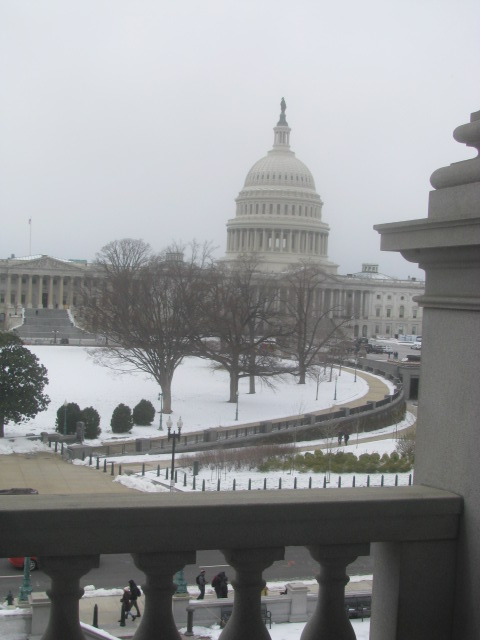
Washington D.C.’s Capitol after a light winter snowfall – All rights incl electr. reserved by Culinary Roots and Recipes 2017
WASHINGTON D.C.’s ANNUAL CHERRY BLOSSOM FESTIVAL:
It all began between 1910 and 1912, during Taft’s presidency, when Japanese Mayor Yokio Ozaki of Tokyo donated 3000 cherry trees to the nation’s capital, honoring the lasting friendship between the two countries. The planting of the trees took place along the northern bank of the Tidal Basin along the West Potomac Park in the presence of First Lady Helen Herron Taft and Viscountess Chinda, wife of the Japanese ambassador. While the first trees planted in 1910 did not do well, those planted in 1912 grew into trees which still bloom today during the first weeks of spring.
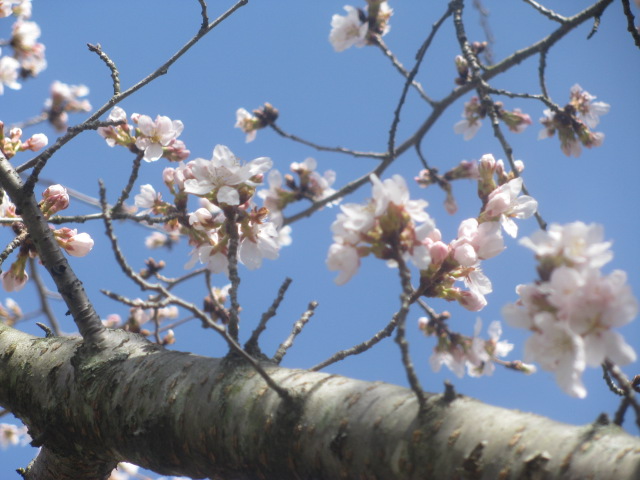
Cherry blossoms in D,C. -All rights reserved incl. electr. by Culinary Roots and Recipes 2017
Admittedly during the months of spring and early summer, the city’s weather is more conducive to tourists strolling around the Mall, sightseeing near the Lincoln Memorial or the ” big pencil”, which is how locals sometimes refer to the 555 foot obelisk known as the Washington Monument. Under a blue sky with the sun shining over the federal capital, for those who wish to explore the historic and political American and international arena, Washington is definitively the all season location to be.

View of Washington D.C from Alexandria, Virginia –
All rights incl electr. reserved by Culinary Roots and Recipes 2017
The nation’s capital offers a variety of tourmobiles from Union Station to Arlington Cemetery, a well run subway system, and many superb monuments and exciting museums. Also interesting are the guided tours throughout the city’s diplomatic neighborhoods where it is possible to find out who’s who or what elegant, decorated embassy building belongs to what country. For those who wish to peruse historical books there is also the amazing Library of Congress. Believe it or not there are also 30,000 cookbooks! Established in 1800 when President Adams had the seat of the U.S. government transferred to Washington D.C., this library is an American treasure for those who research various topics including food and culinary history.
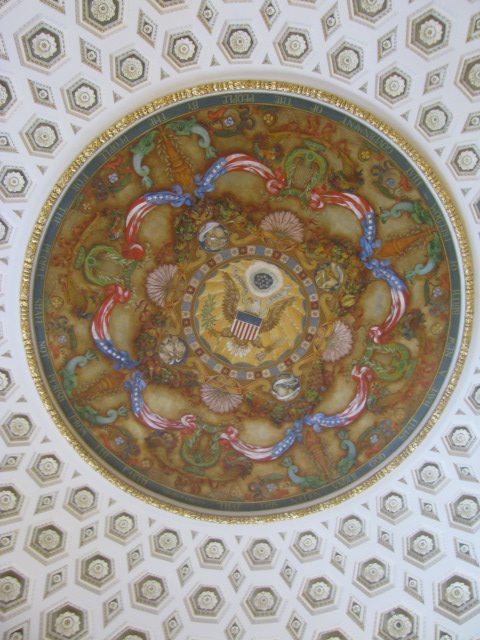
Library of Congress – Thomas Jefferson Building’s ceiling fresco – All rights incl. electr. reserved by Culinary Roots and Recipes 2017

Library of Congress – The Jefferson Building – All rights incl. electr. reserved by Culinary Roots and Recipes 2017
While serving as research resource for members of Congress, the Library also presents interesting food related events which celebrate and explore food ways from faraway lands. Where else but at the Library of Congress could we have learned, free of charge, about Azerbaijani customs and cuisine with pomegranates, Tendir and Lavash breads, sai and sprouted wheat berries used to celebrate Novruz?!
Last month with a friend, I did exactly that: I visited the Jefferson Building, strolled through an early American exhibition, and tasted delicious Novruz food presented by Feride Buyuran from her superb cook book: Pomegranates & Saffron, A Culinary Journey to Azerbaijan.

Feride Buyuran’s Pomegranate & Saffron cookbook – All rights reserved incl. electr. by Culinary Roots and Recipes 2017
Feride Buyuran, who lives in Long Beach, California, earned several awards for her 2014 published cookbook and is also the creator of AZcookbook.com, a food blog of recipes and stories from Azerbaijan.

This tantalizing dish was part of Feride’s Novruz presentation at the Library of Congress – All rights incl. electr. reserved by Culinary Roots and Recipes 2017
RECIPE FROM FERIDE’S COOKBOOK – HOW TO CUT OPEN POMEGRANATE, ALSO CALLED NAR
Locals in Goychay, a city in Azerbaijan hosting an annual pomegranate festival, and Feride claim that this method makes for a completely mess-free cutting of a pomegranate.
First, using a circular motion with a sharp knife, slice off the top part of the pomegranate, about 1/2 inch from the top (you will obtain a lid with a crown). Set the “lid” aside. You will notice that the inside of the fruit is separated into distinct segments by white membranes. Starting from the top, cut down along each segment without fully separating the segments from the core. Then, using your hands, carefully pull the segments apart, making sure they are still attached at the core to form a pomegranate “flower.” Place the “lid” on top for decoration and serve (pg.15).
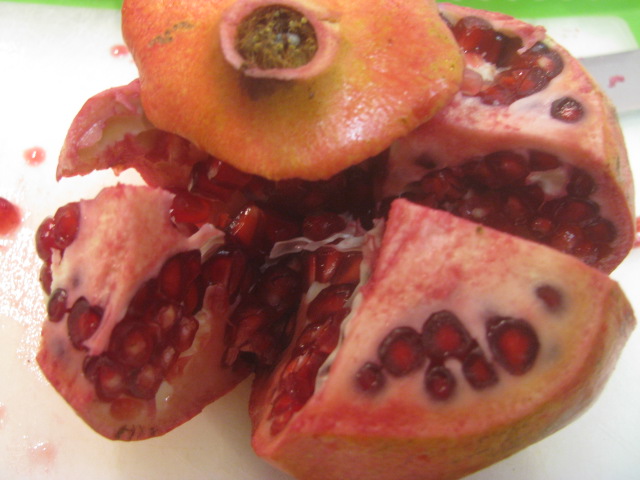
How to cut open a pomegranate – All rights reserved incl. electr. by Culinary Roots and Recipes 2017
FOR MORE ON THE FAMOUS AZERBAIJANI POMEGRANATE FESTIVAL IN GOYCHAY access the internet at http://www.azernews.az/travel/89590.html
HOW TO GROW SEMENI FOR NOVRUZ
Spread a handful of wheatberries over a pretty dessert plate to form a singe layer, without overcrowding the seeds. Sprinkle water on the seeds, then cover with a wet paper towel or cloth. Set the plate in a sunlit part of the room. Check the seeds several times a day to make sure they are moist, and wet the towel or cloth as needed by drizzling it with water. When the sprouted seeds are one quarter-inch tall (in about 3-4 days), remove the towel. Make sure to continue to water the sprouts as needed. On day 10 the sprouts will have grown to a height of about 6-7 inches. The semeni is ready! Tie a red ribbon around the circumference of the sprouts and make the semeni plate a centerpiece on your holiday table (pg.26).
AZERBAJIAN PILAF
Like so many countries located along the ancient Silk Road, Azerbajian is fond of dishes of rice pilaf with various types of crusts. According to Feride’s cookbook, Azerbaijan’s cuisine features three classic ways to make rice pilaf: the dashma pilaf, the suzme pilaf and the edoshem pilaf. The basics of these pilaf methods all include cooked rice prepared with a liquid or water by an absorption method with or without spices or other ingredients (pg. 159). One recipe I found in the book brought back memories of when I used to be invited by Persian friends who still live in Washington D.C. I wrote down Feride’s recipe to celebrate upcoming Easter plans for a get together with an international group of friends.
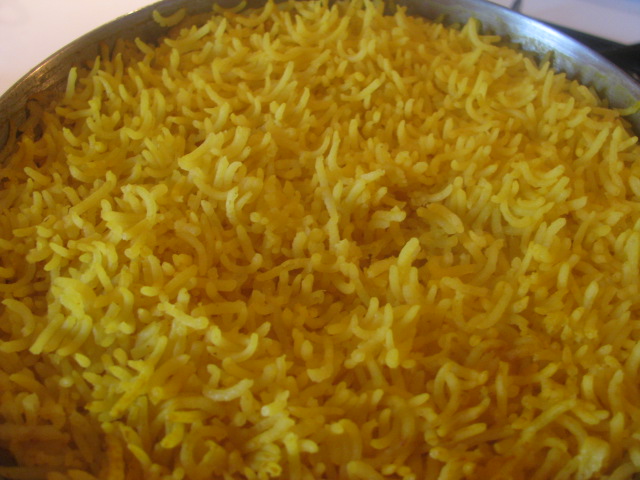
Yellow Turmeric Rice – All Rights incl. electr. reserved by Culinary Roots and Recipes 2017
FERIDE’S TURMERIC RICE PILAF WITH CRUST – Adaptation from her master recipes
ATTENTION: THIS RECIPE REQUIRES TIME AND CAREFUL PREPARATION
Serves 4
For the rice:
3 cups white basmati rice, cooked in water (about 5-6 cups) with 1/2 Tbsp of turmeric (may substitute saffron) and 1/2 Tbsp of salt
Before cooking the rice, rinse the rice 3 times and soak it for 30 minutes in clear water,
Don’t skip the soaking stage – it will allow the rice to turn out fluffy and not sticky. Don’t rinse the kernels after the last soaking.
To prepare and cook the rice, rinse and drain the rice three times in lukewarm water; the water should lose its cloudiness. Before cooking place the rinsed and drained rice one last time in enough lukewarm water to cover it by at least 2 inches and leave it soaking for 30 minutes. Drain the soaked rice but do not rinse it again. Put the drained rice in a large saucepan with the 5-6 cups of water, the salt and the turmeric (or the saffron).
In case you use saffron instead of turmeric: While cooking the rice in the water, add 1 tsp of saffron and stir occasionally while the water reaches the boiling point.
Once the rice has been drained one last time and added to the 5-6 cups of water with the salt and the turmeric, bring the mixture to a boil, stir, cover and cook for 5 minutes, then turn off the heat and leave the rice in the saucepan covered until the rice has absorbed all liquid.
For the crust:
4 Tbsp yogurt or sour cream
1 egg
salt to taste + 1/2 tsp of turmeric
4 Tbsp cold unsalted butter
4 Tbsp unsalted butter, melted
Set the cooked yellow rice aside until you are ready to prepare the crust.
Take 1-1/2 cups of the cooled cooked yellow rice and mix it with the yogurt or sour cream, egg, and a little more turmeric (1/2 tsp).
Melt the cold butter on a non stick flat pan, distribute the yellow yogurt rice mixture over the hot surface and on low heat wait until a golden crust has formed (about 15-20 minutes). When the crust has formed, carefully add the remaining rice, making sure to distribute it over the crusted rice. Drizzle this last portion of rice with the melted butter and cover everything with a lid. Finish the steaming by leaving the rice under the cover for an additional 20-25 minutes.
Flip the mixture upside down onto a serving plate so that the golden crust is on top.
For more brilliant colors, you can serve the crusty rice surrounded by pomegranate kernels, perhaps accompanied by some roasted meat and green cooked vegetables.
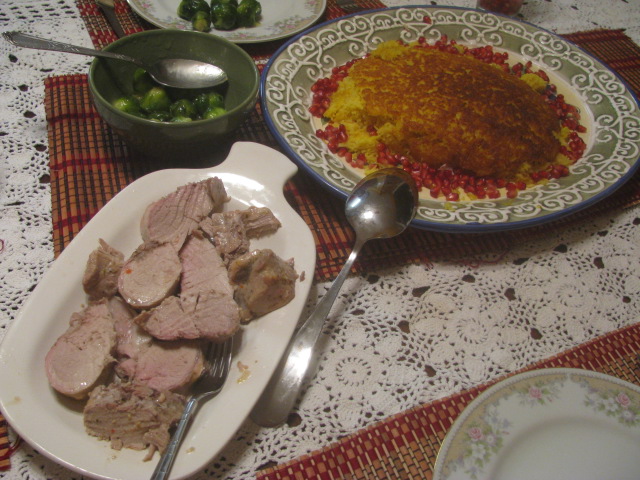
Adaptation of Feride’s crusted turmeric rice served with Brussels sprouts and roasted meat – All rights incl electr. reserved by Culinary Roots and Recipes 2017
LIBRARY OF CONGRESS
10 First Street SE, Washington, DC 20540
Tel. 202 707 8000
Today’s Library of Congress, located in Washington D.C. is among the world’s largest research archives of books, printed material, sound recordings, photographs, maps, sheet music, motion pictures, collection items and manuscripts in 470 languages. The oldest portion of the Library, built between 1890-1897, supports research in the Main Reading Room of the Thomas Jefferson Building and hosts presentations of special cultural events throughout its 19 specialty reading rooms. It serves as an archive for priceless objects, including papers of key figures who played a role in American and world history, and as a stage for special performances and concerts. The Library houses exhibitions that offer a glimpse into American and world history, administrates the U.S. copyright system, and has a library system for the blind and physically handicapped. It is open Monday through Saturday, 8:30 AM to 4:30 PM, closed on New Year’s, Thanksgiving and Christmas.

Exploring Early America – Jay I. Kishek Collection – A Maya Jaguar – All rights reserved incl. electr. by Culinary Roots and Recipes 2017
POMEGRANATES & SAFFRON, A Culinary Journey to Azerbaijan by Feride Buyuran; Awarded book award by Books For Better Living, Best in the World Gourmand and Indie Excellence Book Award, 2014, AZ Cookbook, P.O. Box 2515, Los Alamitos, CA. 90720 at http://www.azcookbook.com
Hardcover, 317 pages of recipes with color photographs, a glossary of terms and foods, with metric conversion charts, and information on typical culinary food practices in Azerbaijan and where to find ingredients on the internet.

Cherry blossoms in Washington D.C. – All rights reserved incl. electr. by Culinary Roots and Recipes 2017
NATIONAL GALLERY OF ART On the National Mall
Between 3rd and 9th Street NW – Tel 202 737 4215
Displays masterworks by renowned European and American artists, and photographs of opinion leaders who impacted modern American culture. It also has the only painting by Leonardo da Vinci in the Americas.
BASILICA OF THE NATIONAL SHRINE OF THE IMMACULATE CONCEPTION
400 Michigan Avenue NE – Tel 202 526 8300
WASHINGTON D.C. 3 HOUR SIGHTSEEING TOUR
Capitol Entertainment Services
3629 18th Street NE – Tel 202 636 3896 or washington-dc-tours.com
FOOD STOPS:
For those who would like to stop for a bite or a full fledged meal between one site and the other, there are the Smithsonian Museum Cafes at the National Museum of American History, at the National Museum of Natural History, at the National Museum of the American Indian and at the Roof Terrace Restaurant & Bar of the Kennedy Center, located high above the Potomac River at 2700 F Street NW (Tel. 202 416 8555).

Washington D.C.’s Potomac River – View from Alexandria, Virginia – All rights incl. electr. reserved by Culinary Roots and Recipes 2017
For visitors who wish to taste and appreciate Azerbaijani cuisine without standing in front of a stove with Feride’s cookbook, there are not many Azerbaijani restaurants in the United States. There are three or four in New York, a few in California and one outside Washington D.C. near Baltimore in Owings Mills, Maryland (about 1 hour drive from the nation’s capital).
KAVKAZ KEBAB – AZERBAIJANI RESTAURANT, 10902 Boulevard Circle, Owings Mills, MD 21117; Tel. 410 998 9004 – email at info@kavkazkebab.com or http://www.kavkazkebab.com

Spring has sprung in Washington D.C. – All rights reserved incl electr. by Culinary Roots and Recipes 2017

